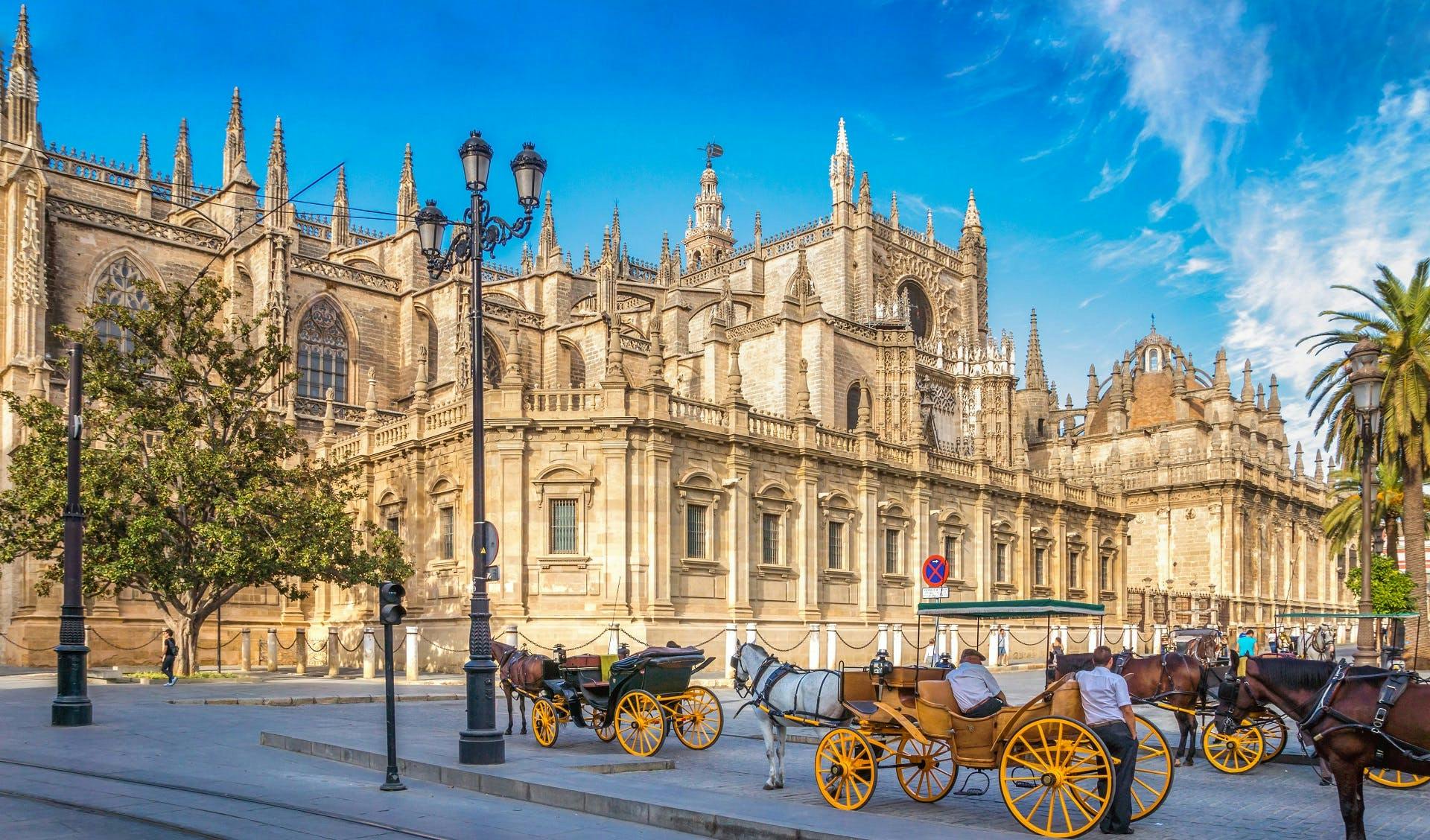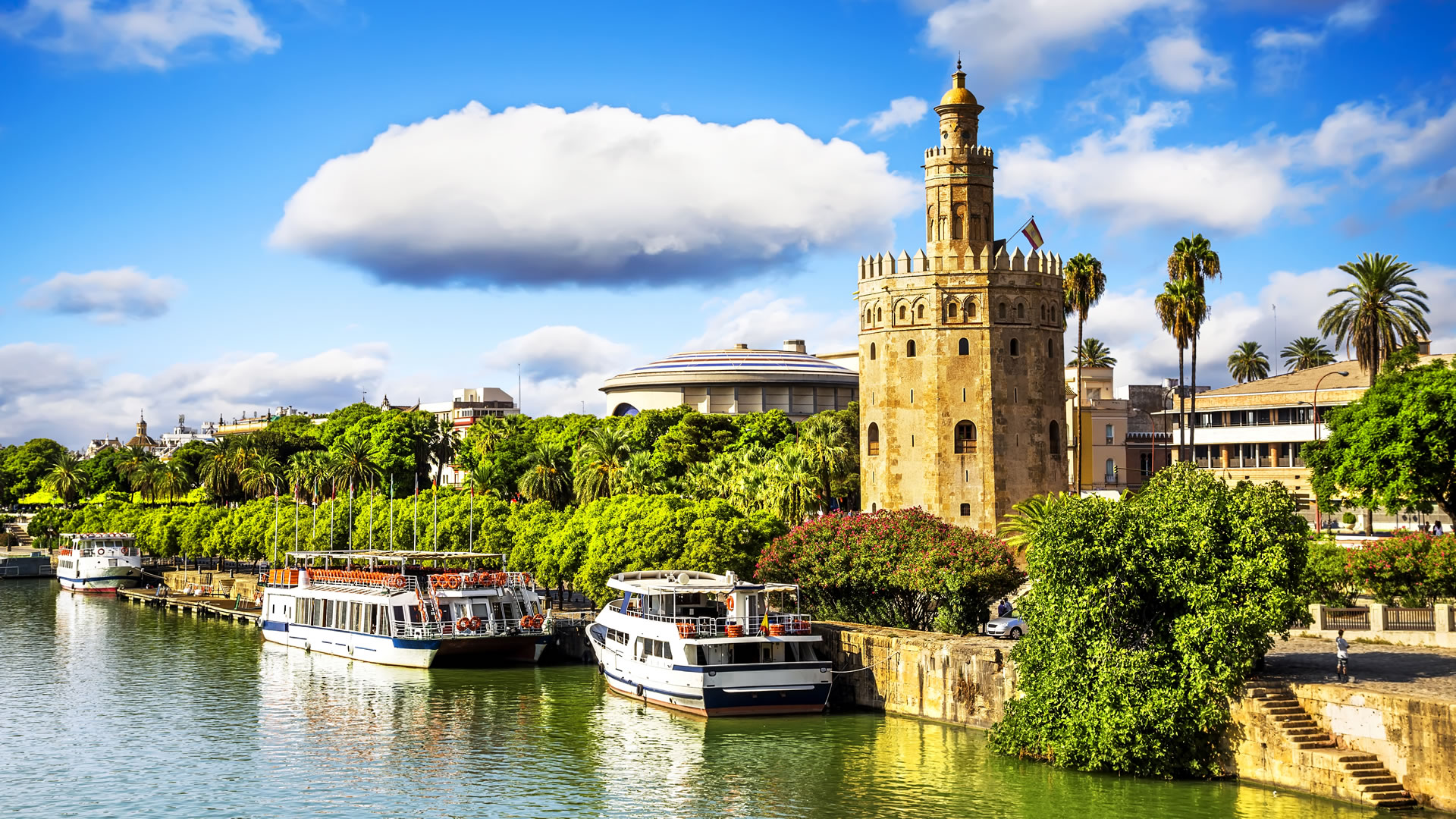It is impossible not to find something to do in the capital of Andalusia, but just in case you run out of plans, here are 10 ideas for organising a sightseeing tour of Seville and the surrounding areas.
Plaza de españa
The «Plaza de España» is an architectural ensemble set in the María Luisa Park. It was built between 1914 and 1929 as one of the main constructions for the Ibero-American Exhibition of 1929. And if you’ve seen «Star Wars: Episode II – Attack of the Clones», you might recognise it as the royal palace on the planet Naboo.
A visit here is a must, especially at sunset. You can also rent a boat to tour the lake inside the square or tour the María Luisa Park on a quad bike.
General admission: free.


Royal Alcazar of Seville
The Royal Alcazar of Seville is a walled palace complex built in different historical periods. Its origins date back to the beginning of the 10th century, during the period of Muslim rule. After the conquest of the city in 1248, the space was used to build a Mudejar and a Gothic palace.
Nowadays it is the residence of the members of the Spanish royal family when they visit Seville, making it the oldest royal palace in use in Europe.
General admission: 13.50 €.
Seville Cathedral
The Seville Cathedral is a Catholic church in the Gothic style. The construction of the current building began in 1401 on the remains of an ancient 12th century mosque.
The building features the famous Giralda, an ancient 12th century minaret that has become a symbol of the city. The temple houses the mortal remains of Christopher Columbus and several kings of Castile.
General admission: 12.00 €.


Metropol Parasol
Metropol Parasol, also known as «Setas de Sevilla» (or «Seville Mushrooms»), is a structure in the form of a wooden and concrete pergola in the centrally located «Plaza de la Encarnación». Designed by Berlin architect Jürgen Mayer, it is one of the largest wooden structures in the world.
Its base houses a traditional market, a public square, and the Antiquarium archaeological museum. The structure is crowned with a terrace offering a panoramic view of the old town.
General admission: 15.00 €.
Hercules Boulevard
The Hercules Boulevard (or «Alameda de Hércules») is a promenade in the historic centre that dates back to 1574, making it one of the oldest public gardens in Europe. The promenade is crowned by two Roman columns with statues of Hercules and Julius Caesar.
Today, it is one of the city’s leading leisure areas, as well as an important meeting point for alternative and queer cultures. It is an ideal place for a night out with its many bars, restaurants, ice cream shops, and nightclubs.


Guadalquivir River
The Guadalquivir River, formerly called «Betis» by the Romans, is the only truly navigable river in Spain. Its course divides the old town from other emblematic areas such as the Triana district or the «Isla de la Cartuja».
Today it is a key point of activity in Seville. You can visit the famous «Torre del Oro» (Gold Tower), which houses a naval museum, ride your bike along the riverbank, take a kayak trip, or hire a cruise to admire the city from the river.
General admission to the «Torre del Oro»: 3.00 €.
Triana District
Triana is a traditional and picturesque district located on the other side of the Guadalquivir river. Historically, it has been the birthplace of bullfighters, sailors, and flamenco artists, attracting many visitors seduced by its tapas, river views, typical market, and small Sevillian tile shops.
You can get there by crossing the emblematic Triana Bridge and then visit the old Castle of San Jorge, the Betis Street, the Triana Ceramics Centre, or its many flamenco venues.
General admission to the Castle of San Jorge and the Triana market: free.


Museum of Fine Arts
Housed in a former 17th-century convent, the Museum of Fine Arts in Seville is one of the most important art galleries in Spain, and is essential for learning about both Sevillian Baroque painting and 19th-century Andalusian painting. The museum is an obligatory stop for any art lover, as it houses works by well-known national artists such as Francisco de Zurbarán, Bartolomé Esteban Murillo, and Diego Velázquez.
General admission: 1.50 €.
CaixaForum Sevilla
CaixaForum Sevilla is a cultural centre founded in March 2017, the work of the prestigious Sevillian architect Guillermo Vázquez Consuegra. The centre, located in the area of the city known as «Isla de la Cartuja» next to the «Torre Sevilla» shopping mall, offers a wide range of cultural, artistic, and educational activities.
General admission: 6.00 €.


Archaeological Site of Italica
Italica is an ancient Roman city located in the present-day municipality of Santiponce, Seville. The city was founded in 206 BC, being the first colony founded in Hispania and also outside Italian territory. It was the birthplace of two great Roman emperors: Trajan and Hadrian.
The remains of what was once the nova urbs include the amphitheatre, the temple of Trajan (Traianeum), the so-called major baths, and various noble family houses.
General admission: free for EU citizens, 1.50 € for all others.
Don’t miss this list of interesting resources from the tourist offices of Seville and Andalusia:
- Seville Tourist Office website (in English)
- Andalusian Tourist Office website (in English)
- Important numbers:
- Emergencies: 112
- National Police: 091
- Local Police: 092
- Ambulance: 061
- Fire brigade: 080
- Healthcare: 902505060
- AENA (Spanish airports): 902404704
- RENFE (national rail services): 902240202

